Periodical cicadas
| Periodical cicada | |
|---|---|
| | |
| Magicicada sp. from brood XXIII, 2015 | |
| | |
| A Magicicada chorus with M. septendecim, M. cassini, and M. septendecula | |
| Scientific classification | |
| Kingdom: | Animalia |
| Phylum: | Arthropoda |
| Class: | Insecta |
| Order: | Hemiptera |
| Suborder: | Auchenorrhyncha |
| Infraorder: | Cicadomorpha |
| Superfamily: | Cicadoidea |
| Family: | Cicadidae |
| Subfamily: | Cicadettinae |
| Genus: | Magicicada W. T. Davis, 1925 |
| Type species | |
| Magicicada septendecim [1] Linnaeus, 1758 | |
Magicicada is the genus of the 13-year and 17-year periodical cicadas of eastern North America. Although they are sometimes called "locusts", this is a misnomer, as cicadas belong to the taxonomic order Hemiptera (true bugs), suborder Auchenorrhyncha, while locusts are grasshoppers belonging to the order Orthoptera.[2]
Magicicada spp. spend most of their 13- and 17-year lives underground feeding on xylem fluids from the roots of deciduous forest trees in the eastern United States.[3] After 13 or 17 years, mature cicada nymphs emerge at any given locality, synchronously and in tremendous numbers. After such a prolonged developmental phase, the adults are active for about 4 to 6 weeks.[4] The males aggregate into chorus centers and attract mates. Within two months of the original emergence, the lifecycle is complete, the eggs have been laid, and the adult cicadas are gone for another 13 or 17 years.
Description
The familiar winged imago (adult) periodical cicada has red eyes and a black dorsal thorax. The wings are translucent and have orange veins. The underside of the abdomen may be black, orange, or striped with orange and black, depending on the species.[5]
Adults are typically 2.4 to 3.3 cm (0.9 to 1.3 in), depending on species, slightly smaller than the annual cicada species found in the same regions of the United States. Mature females are slightly larger than males.[6]
Magicicada males typically form large aggregations that sing in chorus to attract receptive females. Different species have different characteristic calling songs. The call of decim periodical cicadas is said to resemble someone calling "weeeee-whoa" or "Pharaoh."[7] The cassini and decula periodic cicadas (including M. tredecula) have songs that intersperse buzzing and ticking sounds.[6]
Cicadas do not sting and do not normally bite. Like other Auchenorrhyncha bugs, they have mouthparts used in piercing plants and sucking their sap. A cicada's proboscis can pierce human skin when it is handled, which is painful, but in no other way harmful. These cicadas are not venomous, and no evidence shows they transmit diseases. They pose little threat to mature vegetation, although planting new trees or shrubs is best postponed until after an expected emergence of the periodical cicadas. Mature plants rarely suffer lasting damage, although twig die-off or flagging can result from egg-laying.[8]
Lifecycle
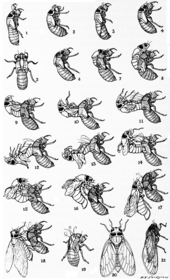
Nearly all cicadas spend years underground as juveniles, before emerging above ground for a short adult stage of several weeks to a few months. The seven periodical cicada species are so named because, in any one location, all of the members of the population are developmentally synchronized—they emerge as adults all at once in the same year. This periodicity is especially remarkable because their lifecycles are so long—13 or 17 years. Cicadas of all other species (perhaps 3000 worldwide) are not synchronized, so some adults mature each summer and emerge while the rest of the population continues to develop underground. Many people refer to these nonperiodical species as annual cicadas since some are seen every summer. The lifecycles of most annual species range from two to 10 years, although some could be longer.
The nymphs of the periodical cicadas live underground, usually within 2 ft (61 cm) of the surface, feeding on the juices of plant roots.[9] The nymphs of the periodical cicada undergo five instar stages in their development underground. The difference in the 13- and 17-year lifecycle is the time it takes for the second instar to mature. While underground, the nymphs move deeper below ground, feeding on larger roots.[10]
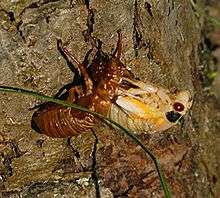
The nymphs emerge on a spring evening when the soil temperature at about 20 cm (8 in) depth is above 17.9 °C (64 °F). In most years in the United States, this works out to late April or early May in the far south, and late May to early June in the far north. Emerging nymphs climb to a suitable place on the nearby vegetation to complete their transformation into adults. They molt one last time and then spend about six days in the leaves waiting for their exoskeletons to harden completely. Just after this final molt, the teneral adults are white, but darken within an hour.

Adult periodical cicadas live only for a few weeks; by mid-July, all have disappeared. Their short adult lives have one purpose: reproduction. The males "sing" a species-specific mating song; like other cicadas, they produce loud sounds using their tymbals. Singing males of a single Magicicada species form aggregations (choruses) that are sexually attractive to females. Males in these choruses alternate bouts of singing with short flights from tree to tree in search of receptive females.[11] Most matings occur in "chorus" trees.[5]
Receptive females respond to the calls of conspecific males with timed wing-flicks, which attract the males for mating.[12] The sounds of a "chorus"—a group of males—can be deafening and reach 100 dB. In addition to their "calling" or "congregating" song, males produce a distinctive courtship song when approaching an individual female.[5]

Both males and females can mate multiple times, although most females seem to mate just once. After mating, the female cuts V-shaped slits in the bark of young twigs and lays about 20 eggs in each, for a total of 600 or more eggs. After about six to 10 weeks, the eggs hatch and the newborn nymphs drop to the ground, where they burrow and begin another 13- or 17-year cycle.
Predator satiation survival strategy
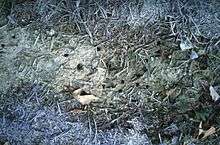
The nymphs emerge in large numbers about the same time, sometimes more than 1.5 million individuals per acre (>370/m²).[13] Their mass emergence is a survival trait called predator satiation: for the first week after emergence, the periodical cicadas are an easy prey for reptiles, birds, squirrels, cats, and other small and large mammals.[4][14] Early ideas maintained that the cicadas' overall survival mechanism was simply to overwhelm predators by their sheer numbers, ensuring the survival of most of the individuals. The emergence period of large prime numbers (13 and 17 years) was hypothesized to be a predator avoidance strategy adopted to eliminate the possibility of potential predators receiving periodic population boosts by synchronizing their own generations to divisors of the cicada emergence period.[15] Another viewpoint holds that the prime-numbered developmental times represent an adaptation to prevent hybridization between broods with different cycles during a period of heavy selection pressure brought on by isolated and lowered populations during Pleistocene glacial stadia, and that predator satiation is a short-term maintenance strategy.[16] This hypothesis was subsequently supported through a series of mathematical models, and stands as the most widely accepted explanation of the unusually lengthy and mathematically precise immature period of these insects.[17] The length of the cycle was hypothesized to be controlled by a single gene locus, with the 13-year cycle dominant to the 17-year one,[18] but this interpretation remains controversial and unexplored at the DNA level.
Impact on other populations
Cycles in cicada populations are significant enough to affect other animal and plant populations. For example, tree growth has been observed to decline the year before the emergence of a brood, because of the increased feeding on roots by nymphs.[19] Moles, which feed on nymphs, have been observed to do well during the year before an emergence, but suffer population declines the following year, because of the reduced food source.[20] Wild turkey populations respond favorably to increased nutrition in their food supply from gorging on cicada adults on the ground at the end of their lifecycles. Uneaten carcasses of periodic cicadas decompose on the ground, providing a resource pulse of nutrients to the forest community.[19]
Cicada broods may also have a negative impact. Eastern gray squirrel populations have been negatively affected, because the egg-laying activity of female cicadas damaged upcoming mast crops.
Broods
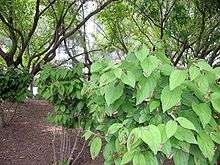
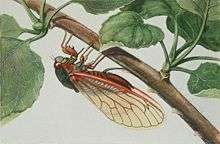
Periodical cicadas are grouped into broods based on the calendar year when they emerge (see chart below and maps on www.magicicada.org). For example, in 2014, the 13-year brood XXII emerged in Louisiana and the 17-year brood III emerged in western Illinois and eastern Iowa.
In 1898, entomologist C. L. Marlatt assigned Roman numerals to 30 different broods of periodical cicadas: 17 distinct broods with a 17-year lifecycle, to which he assigned brood numbers I through XVII (with emerging years 1893 through 1909); plus 13 broods with a 13-year cycle, to which he assigned brood numbers XVIII through XXX (1893 through 1905).[21]
Many of these hypothetical 30 broods, however, have not been observed. Furthermore, two of the brood numbers assigned by Marlatt (broods XI and XXI) existed at one time, but have become extinct. The Marlatt numbering scheme has been retained for convenience (and because it clearly separates 13- and 17-year lifecycles), although today only 15 broods are known to survive.[22]
| Name | Nickname | Cycle (yrs) | Last emergence | Next emergence | Extent |
|---|---|---|---|---|---|
| Brood I | Blue Ridge brood | 17 | 2012 | 2029 | Western VA, WV |
| Brood II | East Coast brood | 17 | 2013 | 2030 | CT, MD, NC, NJ, NY, PA, DE, VA, DC |
| Brood III | Iowan brood | 17 | 2014 | 2031 | IA |
| Brood IV | Kansan brood | 17 | 2015 | 2032 | Eastern NE, southeastern IA, eastern KS, western MO, OK, north TX |
| Brood V | 17 | 2016 | 2033 | Eastern OH, Western MD, Southwestern PA, Northwestern VA, WV[23] | |
| Brood VI | 17 | 2000 | 2017 | Northern GA, western NC, northwestern SC | |
| Brood VII | Onondaga brood | 17 | 2001 | 2018 | Ontario, Yates, and Seneca Counties NY[Note 1] |
| Brood VIII | 17 | 2002 | 2019 | Eastern OH, western PA, northern WV | |
| Brood IX | 17 | 2003 | 2020 | Western VA, southern WV, western NC | |
| Brood X | Great eastern brood | 17 | 2004 | 2021 | NY, NJ, PA, DE, MD, DC, VA, WV, NC, GA, TN, KY, OH, IN, IL, MI[24][Note 2] |
| Brood XI | 17 | 1954 | Extinct | Last seen in 1954 in Ashford, CT along the Fenton River | |
| Brood XIII | Northern Illinois brood | 17 | 2007 | 2024 | Northern IL and in parts of IA, WI, and IN[Note 3] |
| Brood XIV | 17 | 2008 | 2025 | Southern OH, KY, TN, MA, MD, NC, PA, northern GA, western VA and WV, and parts of NY and NJ[Note 3] | |
| Brood XIX | Great Southern Brood | 13 | 2011 | 2024 | AL, AR, GA, IN, IL, KY, LA, MD, MO, MS, NC, OK, SC, TN, and VA[Note 4] |
| Brood XXI | Floridian Brood | 13 | 1870 | Extinct | Last recorded in 1870, historical range included the FL panhandle |
| Brood XXII | Baton Rouge brood[26] | 13 | 2014 | 2027 | LA, MS[Note 5] |
| Brood XXIII | Lower Mississippi River Valley brood | 13 | 2015 | 2028 | AR, IL, IN, KY, LA, MO, MS, TN |
Taxonomy
Seven recognized species are placed within Magicicada. Three of them follow a 17-year cycle:
- M. septendecim (Linnaeus, 1758)
- M. septencassini (Fisher, 1851) (also called M. cassini)
- M. septendecula Alexander & Moore, 1962
Four more species follow a 13-year cycle:
- M. neotredecim Marshall & Cooley, 2000
- M. tredecim (Walsh & Riley, 1868)
- M. tredecassini Alexander & Moore, 1962
- M. tredecula Alexander & Moore, 1962
These seven species are also sometimes grouped differently into three subgroups, the so-called Decim species group, Cassini species group, and Decula species group, reflecting strong similarities of each 17-year species with one or more species with a 13-year cycle.[27]
Distribution
Generally, the 17-year cicadas are distributed more in the northern states of the eastern United States, while the 13-year cicadas occur in the southern states, but some may overlap slightly. For example, Broods IV (17-year cycle) and XIX (13-year cycle) overlap in western Missouri and eastern Oklahoma.[28][29] Their emergences should again coincide in 2219, 2440, 2661, etc., as they did in 1998[30] (although distributions change slightly from generation to generation and older distribution maps can be unreliable.[29]). An effort is currently underway to generate new distribution maps of all periodical cicada broods. This effort makes use of crowdsourced records and records collected by entomologists.[31]
Evolution
Not only are the periodical cicada lifecycles curious for their prime numbers 13 or 17, but also their evolution is intricately tied to one- and four-year changes in their lifecycles.[16][18] One-year changes are less common than four-year changes and are probably tied to variation in local climatic conditions. Four-year early and late emergences are common and involve a much larger proportion of the population than one-year changes.
Recent research suggests, in extant periodical cicadas, the 13- and 17-year lifecycles evolved at least eight different times in the last 4 million years and that different species with identical lifecycles developed their overlapping geographic distribution by synchronization of lifecycle to existing dominant populations.[32] The same study estimates that the Decim species group split from the common ancestor of the Decula plus Cassini species groups around 4 million years ago (Mya). At around 2.5 Mya, the Cassini and Decula groups split from each other.
The Sota et al. (2013) paper also calculates that the first separation of extant 13-year cicadas from 17-year cicadas took place in the Decim group about 530,000 years ago when the southern M. tredecim split from the northern M. septendecim. The second noteworthy event took place about 320,000 years ago with the split of the western Cassini group from its conspecifics to the east. The Decim and the Decula clades experienced similar western splits, but these are estimated to have taken place 270,000 and 230,000 years ago, respectively. The 13- and 17-year splits in Cassini and Decula took place after these events.
The 17-year cicadas largely occupy formerly glaciated territory, and as a result their phylogeographic relationships, reflect the effects of repeated contraction into glacial refugia (small islands of suitable habitat) and subsequent re-expansion during multiple interglacial periods. In each species group, Decim, Cassini, and Decula, the signature of the glacial periods is manifested today in three phylogeographic genetic subdivisions: one subgroup east of the Appalachians, one midwestern, and one on the far western edge of their range.
The Sota et al. data suggest that the founders of the southern 13-year cicada populations seen today originated from the Decim group. These were later joined by Cassini originating from the western Cassini clade and Decula originating from eastern, middle, and western Decula clades. As Cassini and Decula invaded the south, they became synchronized with the resident M. tredecim. Today, these Cassini and Decula are known as M. tredecassini and M. tredecula. More data are needed to lend support to this hypothesis and others hypotheses related to more recent 13- and 17-year splits involving M. neotredecim and M. tredecim.
History
Historical accounts cite reports of 15- to 17-year recurrences of enormous numbers of noisy emergent cicadas ("locusts") written as early as 1737.[33][34] Pehr Kalm, a Swedish naturalist visiting Pennsylvania and New Jersey in 1749 on behalf of his nation's government, observed in late May one such emergence.[33][35] When reporting the event in a Swedish academic journal in 1756, Kalm wrote:
The general opinion is that these insects appear in these fantastic numbers in every seventeenth year. Meanwhile, except for an occasional one which may appear in the summer, they remain underground.
There is considerable evidence that these insects appear every seventeenth year in Pennsylvania.[35]
Kalm then described documents (including one from Benjamin Franklin) that had recorded the emergence from the ground of large numbers of cicadas in Pennsylvania in May 1715 and May 1732. He noted that the people who had prepared these documents had made no such reports in other years.[35] Kalm further noted that others had seen cicadas only occasionally before the large swarms of 1749.[35] He stated that he had not heard any cicadas in Pennsylvania and New Jersey in 1750 in the same months and areas in which he had heard many in 1749.[35]
Kalm summarized his findings in a paper translated into English in 1771,[36] stating:
There are a kind of locusts which about every seventeen years come hither in incredible numbers .... In the interval between the years when they are numerous, they are only seen or heard single in the woods.[33][36]
Based on Kalm's account and a specimen that Kalm had provided, Carl Linnaeus named the insect Cicada septendecim in the tenth edition of his Systema Naturae, in 1758.[5][37]
In 1766, Moses Bartram described in his Observations on the cicada, or locust of America, which appears periodically every 16 or 17 years the next appearance of the brood that Kalm had observed in 1749. Bartram noted that upon hatching from eggs deposited in the twigs of trees, the young insects ran down to the earth and "entered the first opening that they could find". He reported that he had been able to discover them 10 feet (3 m) below the surface, but that others had reportedly found them 30 feet (9 m) deep.[38]
In 1775, Thomas Jefferson recorded in his "Garden Book" the insect's 17-year periodicity, writing that an acquaintance remembered "great locust years" in 1724 and 1741, that he and others recalled another such year in 1754 and that the insects had again emerged from the ground at Monticello in 1775. He noted that the females lay their eggs in the small twigs of trees while above ground.[39]
In April 1800, Benjamin Banneker, who lived near Ellicott's Mills, Maryland, wrote in his record book that he recalled a "great locust year" in 1749, a second in 1766 during which the insects appeared to be "full as numerous as the first", and a third in 1783. He predicted that the insects "may be expected again in the year 1800, which is seventeen years since their third appearance to me".[40]
Use as human food
Magicicada species are edible when cooked. They have historically been eaten by Native Americans, who roasted them in hot ovens, stirring them until they were well browned.[41]
Charles Lester Marlatt wrote in 1907, "The use of the newly emerged and succulent cicadas as an article of human diet has merely a theoretical interest, because, if for no other reason, they occur too rarely to have any real value. There is also the much stronger objection in the instinctive repugnance which all insects seem to inspire as an article of food to most civilized nations. Theoretically, the Cicada, collected at the proper time and suitably dressed and served, should be a rather attractive food. The larvae have lived solely on vegetable matter of the cleanest and most whole-some sort, and supposedly, therefore, would be much more palatable and suitable for food than the oyster, with its scavenger habit of living in the muddy ooze of river bottoms, or many other animals which are highly prized and which have not half so clean a record as the periodical Cicada."[42]
References
- ↑ Maxine Shoemaker Heath (1978). Genera of American cicadas north of Mexico (Ph.D. thesis). University of Florida. doi:10.5962/bhl.title.42291.
- ↑ "Periodical Cicada". magicicada.org.
- ↑ Lloyd, M. & H.S. Dybas (1966). "The periodical cicada problem. I. Population ecology". Evolution. 20 (2): 133–149. doi:10.2307/2406568. JSTOR 2406568.
- 1 2 Williams, K.S. & C. Simon (1995). "The ecology, behavior, and evolution of periodical cicadas" (PDF). Annual Review of Entomology. 40: 269–295. doi:10.1146/annurev.en.40.010195.001413.
- 1 2 3 4 Alexander, Richard D.; Moore, Thomas E. (1962). "The Evolutionary Relationships of 17-Year and 13-Year Cicadas, and Three New Species (Homoptera, Cicadidae, Magicicada)" (PDF). University of Michigan Museum of Zoology. Retrieved 9 June 2011.
- 1 2 Capinera, John L. (2008). Encyclopedia of Entomology. Springer. pp. 2785–2794. ISBN 1-4020-6242-7.
- ↑ Stranahan, Nancy. "Nature Notes from the Eastern Forest". Arc of Appalachia. Retrieved 10 June 2011.
- ↑ Cook, William M.; Robert D. Holt (2002). "Periodical cicada (Magicicada cassini) oviposition damage: visually impressive yet dynamically irrelevant" (PDF). American Midland Naturalist. 147 (2): 214–224. doi:10.1674/0003-0031(2002)147[0214:PCMCOD]2.0.CO;2.
- ↑ Marlatt, C. L. (1907). The Periodical Cicada (Bulletin No. 71 - U.S. Department of Agriculture, Bureau of Entomology). Washington, D.C.: United States Government Printing Office. pp. 123–125.
- ↑ White, J, and M. Lloyd. 1979. Seventeen year cicadas emerging after eighteen years-a new brood? Evolution 33:1193-1199.
- ↑ "Magicicada Broods III and XXII will emerge in 2014". www.magicicada.org.
- ↑ "Sexual Signals in Periodical Cicadas" (PDF). Behaviour.
- ↑ Dybas, H. S.; Davis, D. D. (1962). "A populations census of seventeen-year periodical cicadas (Homoptera: Cicadidae: Magicicada)". Ecology. 43 (3): 432–444. doi:10.2307/1933372. JSTOR 1933372.
- ↑ Williams, K. S.; Smith, K. G.; Stephen, F. M. (1993). "Emergence of 13-year periodical cicadas (Cicadidae, Magicicada): phenology, mortality, and predator satiation". Ecology. 74 (4): 1143–1152. doi:10.2307/1940484. JSTOR 1940484.
- ↑ Goles, E.; Schulz, O.; Markus, M. (2001). "Prime number selection of cycles in a predator-prey model". Complexity. 6 (4): 33–38. doi:10.1002/cplx.1040.
- 1 2 Cox, R. T. & C. E. Carlton (1988). "Paleoclimatic influences in the evolution of periodical cicadas (Homoptera: Cicadidae: Magicicada spp.)". American Midland Naturalist. 120 (1): 183–193. doi:10.2307/2425898. JSTOR 2425898.
- ↑ Tanaka, Y, J. Yoshimura, C. Simon, J. Cooley, and K. Tainaka (2009). "Allee effect in the selection for prime-numbered cycles in periodical cicadas". Proceedings of the National Academy of Sciences. 106 (22): 8975–8979. Bibcode:2009PNAS..106.8975T. doi:10.1073/pnas.0900215106. PMC 2690011
 . PMID 19451640.
. PMID 19451640. - 1 2 Cox, R. T. & C. E. Carlton (1991). "Evidence of genetic dominance of the 13-year life cycle in periodical cicadas (Homoptera: Cicadidae: Magicicada spp.)". American Midland Naturalist. 125 (1): 63–74. doi:10.2307/2426370. JSTOR 2426370.
- 1 2 Yang, Louie H. (2004). "Periodical cicadas as resource pulses in North American forests". Science. 306 (5701): 1565–1567. Bibcode:2004Sci...306.1565Y. doi:10.1126/science.1103114. PMID 15567865.
- ↑ National Geographic: Cicada Outbreaks Linked to Other Animals' Booms, Busts.
- ↑ Marlatt, C. L. (1907). The Periodical Cicada (Bulletin No. 71 - U.S. Department of Agriculture, Bureau of Entomology). Washington, D.C.: United States Government Printing Office. p. 28.
- ↑ Post, Susan L. (2004). "A Trill of a Lifetime". The Illinois Steward. Retrieved 9 June 2011.
- ↑ "Periodical Cicada - Brood V". Forest Service. United States Department of Agriculture. Accessed on April 15, 2016.
- ↑ "Brood X (17-year)". Museum of Zoology, Division of Insects. University of Michigan. Archived from the original on September 27, 2015.
- ↑ "Swarms of cicadas emerging in Midwest". Associated Press. 20 May 2007.
- ↑ "Brood XXII (13-year) The Baton Rouge Brood". National Geographic Society. Retrieved 28 August 2011.
- ↑ "Magicicada species". National Geographic Society. Retrieved 12 June 2011.
- ↑ Compare brood IV distribution with brood XIX distribution. From http://www.magicicada.org http://www.magicicada.org/about/brood_pages/broods.php
- 1 2 See figure 1, p. 107, Cooley et al. The distribution of periodical cicadas. American Entomologist, 55:2, 106-112.
- ↑ Lifecycles Of Cicada Species Are Focus Of Biologist's Research, The UConn Advance, 4/26/2004, Elizabeth Omara-Otunnu
- ↑ http://www.magicicada.org
- ↑ Teiji Sota; Satoshi Yamamoto; John R. Cooley; Kathy B. R. Hill; Chris Simon; Jin Yoshimura (2013). "Independent divergence of 13- and 17-y life cycles among three periodical cicada lineages". Proceedings of the National Academy of Sciences of the United States of America. 110 (2). Bibcode:2013PNAS..110.6919S. doi:10.1073/pnas.1220060110. Retrieved 22 March 2013.
- 1 2 3 Marlatt, C.L (1898). The Periodical Cicada in Literature. The Periodical Cicada: An Account of Cicada Septendecim, Its Natural Enemies and the Means of Preventing its Injury, Together With A Summary of the Distribution of the Different Broods (Bulletin No. 14 - New Series, U.S. Department of Agriculture, Division of Entomology). Washington, D.C.: United States Government Printing Office. pp. 112–118. OCLC 10684275.
- ↑ Kritsky, Gene (2004). "John Bartram and the Periodical Cicadas: A Case Study". In Hoffmann, Nancy E. and Van Horne, John C. America's Curious Botanist: A Tercentennial Reappraisal of John Bartram 1699-1777. Philadelphia, Pennsylvania: The American Philosophical Society. pp. 43–51.
- 1 2 3 4 5 Davis, J.J. (May 1953). "Pehr Kalm's Description of the Periodical Cicada, Magicicada septendecim L., from Kongl. Svenska Vetenskap Academiens Handlinger, 17:101-116, 1756, translated by Larson, Esther Louise (Mrs. K.E. Doak)". The Ohio Journal of Science. 53: 139–140. Archived from the original (PDF) on 2012-10-02. Republished by Knowledge Bank: The Ohio State University Libraries and Office of the Chief Information Officer.
- 1 2 Kalm, Peter (1771). Travels into North America: Translated into English, By John Reinhold Foster. 2. London: T. Lowndess. pp. 212–213.
- ↑ Linnaei, Caroli (1758). "Insecta. Hemiptera. Cicada. Mannifera. septendecim.". Systema Naturae Per Regna Tria Naturae, Secundum Classes, Ordines, Genera, Species, Cum Characteribus, Differentiis, Synonymis, Locis. 1 (10 ed.). Stockholm, Sweden: Laurentii Salvii. pp. 436–437.
- ↑ Bartram, Moses (1766). Observations on the cicada, or locust of North America, which appears periodically once in every 16 or 17 years. Communicated by the ingenious Peter Collinson, Esq. The Annual Register, or a View of the History, Politicks, and Literature, for the Year 1767. London: Printed for J. Dodsley (1768). pp. 103–106. OCLC 642534652.
- ↑ Jefferson, Thomas (1775). Betts, Edward Morris, ed. Thomas Jefferson's garden book, 1766-1824, with relevant extracts from his other writings. Thomas Jefferson Foundation, Inc. (2008). p. 68. ISBN 1-882886-11-9. OCLC 836062827.
Dr. Walker sais he remembers that the years 1724 and 1741 were great locust years. we all remember that 1758 was and now they are come again this year of 1775. it appears that they come periodically from the ground once in 17 years. they come out of the ground from a prodigious depth. it is thought they eat nothing while in this state, laying their eggs in the small twigs of trees seems to be their only business. The females make a noise well known. The males are silent.
- ↑ (1) Latrobe, John H. B., Esq. (1845). Memoir of Benjamin Banneker: Read before the Maryland Historical Society at the Monthly Meeting, May 1, 1845. Baltimore, Maryland: Printed by John D. Toy. pp. 11–12. OCLC 568468091. Retrieved 2015-10-07.
(2) Barber, Janet E.; Nkwanta, Asamoah (2014). "Benjamin Banneker's Original Handwritten Document: Observations and Study of the Cicada". Journal of Humanistic Mathematics. 4 (1): 112–114. doi:10.5642/jhummath.201401.07. Retrieved 2014-08-26. - ↑ Marlatt, C. L. (1907). The Periodical Cicada (Bulletin No. 71 - U.S. Department of Agriculture, Bureau of Entomology). Washington, D.C.: United States Government Printing Office. p. 103.
- ↑ Marlatt, C. L. (1907). The Periodical Cicada (Bulletin No. 71 - U.S. Department of Agriculture, Bureau of Entomology). Washington, D.C.: United States Government Printing Office. p. 104.
External links
| Wikimedia Commons has media related to Magicicada. |
| Wikispecies has information related to: Periodical cicadas |
- Magicicada Lab Exercise for High School AP Biology, College and University Classes Multiple field and laboratory exercises that contribute to research on the ecology and evolution of periodical cicadas in collaboration with scientists at the University of Connecticut]
- Massachusetts Cicadas describes behavior, sightings, photos, "how to find" guide, videos and distribution maps of New England and U.S. periodical and annual cicada species including Brood X, Brood XIII, Brood XIV and Brood XIX
- Magicicada.org Brood mapping project solicits records and observations from the general public
- Cicada Mania
- Comprehensive website with reprints, distribution records, databases, and maps at Cicada Central.
- Comprehensive web site University of Michigan
- Bibliography
- Link list
- Roar of the Cicada
- InsectSingers.com Recordings of species-specific songs of many North American cicada species.
- Liebhold, A.M.; Bohne, M.J.; Lilja, R.L. "Active Periodical Cicada Broods of the United States" (map). USDA Forest Service Northern Research Station, Northeastern Area State and Private Forestry. 2013.